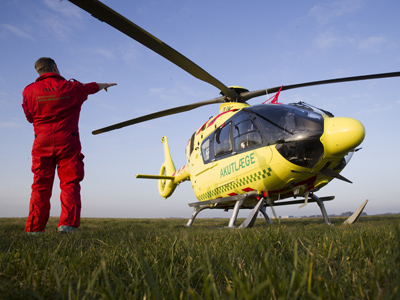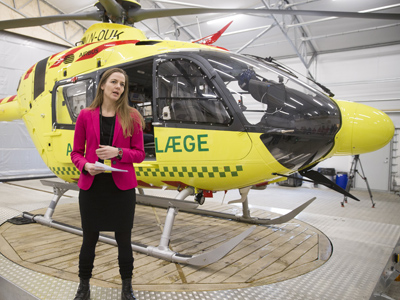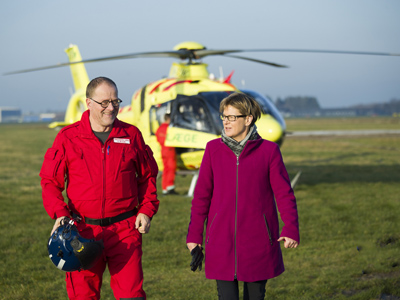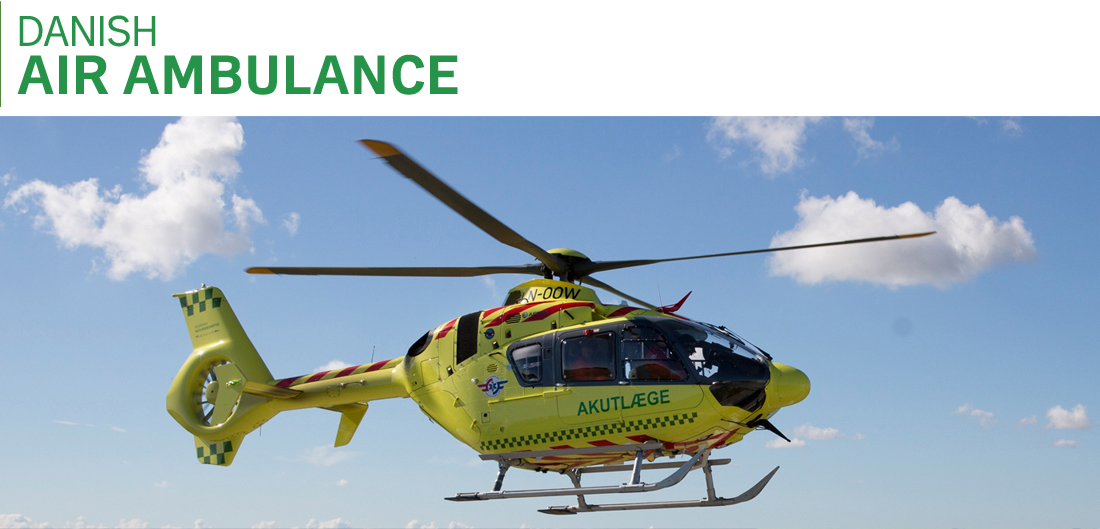
All photos: Photographer Niels Åge Skovbo
Denmark’s fourth emergency medical helicopter will begin carrying patients at noon on 2 January 2019. This was marked by a visit by selected healthcare sector politicians, who were invited on board the helicopter. The visit took place on 17 December 2018 on a temporary base established at Aalborg Airport until the permanent base is ready at Saltum in Jammerbugten.

Deputy Chairman of Danish Regions, Ulla Astman, welcomed the visitors. This was followed by speeches, including from the Minister for Health, Ellen Trane Nørby, whose speech included the following comments:
“The location of the new helicopter in the northern part of Denmark means that we can reduce the response time by approximately 20 minutes for a citizen living in Skagen or on Læsø. It’s about ensuring safety and quick help for all citizens in Denmark.”
Health sector politicians taken for a spin
The guests were then given the opportunity to take a closer look at the helicopter and base facilities, and several health sector politicians were taken for a short spin in the helicopter.

Deputy Chairman of Danish Regions, Ulla Astman, was also happy with the new helicopter:
“Today is a really good day for the North Denmark Region. The new helicopter will provide much better coverage of Vendsyssel, Skagen and Læsø than we’ve had before. I’m extremely pleased with this,” said Ulla Astman, and added:
“At the same time, it’s important for me to stress that this helicopter is not only a Northern Jutland helicopter.” Since 2014, all five regions have operated a joint service with three helicopters which fly to critically ill patients throughout Denmark. The new helicopter will be an integral part of this service and the public health service in the five regions.
“It will not stick to the regional boundaries, but will fly to locations where there’s a healthcare need for the service.”
Facts about Danish Air Ambulance and the fourth helicopter
- Danish Air Ambulance is operated jointly by the regions, and the operations are funded by the Danish State.
- In the Finance Act for 2018, the Danish Government and the Danish People’s Party allocated funds to strengthen the emergency response in areas for which there are relatively long flight times with the current three emergency medical helicopters.
- The parties allocated DKK 45 million a year from 2019 and onwards to establish and operate a fourth emergency medical helicopter based in the northern part of Denmark.
- The fourth emergency medical helicopter will become operational at noon on 2 January 2019. It will have a temporary base at Aalborg Airport, until the base at Saltum, in the northern part of the Municipality of Jammerbugt, has been established.
- The new helicopter is supplied by Norsk Luftambulanse A/S, which already operates the other three emergency medical helicopters.
- The emergency medical helicopters contribute to ensuring that acutely ill citizens with life-threatening symptoms who reside or are staying far from Denmark’s specialised hospitals are provided with quick access to prehospital specialist medical treatment and are ensured fast transport to specialised and highly specialised treatment facilities in line with these treatment facilities having been centralised at the university hospitals.
- The emergency medical helicopters are manned with a crew of three persons: An experienced prehospital emergency physician, a paramedic (an HCM) and a pilot.
- The emergency medical helicopters are not subject to either regional or administrative restrictions and may be dispatched to all parts of Denmark if such emergency assistance is needed.
- More than every third flight is to a patient with cardiovascular disease symptoms. Other large groups are patients with blood clot or brain haemorrhage symptoms and patients with severe injuries, for example after major traffic accidents.
- The current three emergency medical helicopters are based in Skive, Billund and Ringsted and they flew more than 3,600 times in 2017. Preliminary figures for 2018 show an activity increase of between 10 and 15%.
